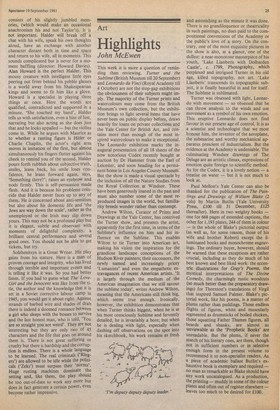Art
Highlights
John McEwen
This week it is more a question of reminding than reviewing. Turner and the Sublime (British Museum till 20 September) and Leonardo da Vinci (Royal Academy till 4 October) are not the stop-gap exhibitions the obviousness of their subjects might imply. The majority of the Turner prints and watercolours may come from the British Museum's own collection, but the exhibition brings to light several items that have never been on public display before, draws heavily for loans on private collections and the Yale Center for British Art, and contains more than enough of the most inspired watercolours to make it exceptional. The Leonardo exhibition marks the inaugural presentation of all 18 sheets of the now notorious Codex recently bought at auction by Dr Hammer from the Earl of Leicester, and soon heading for a permanent home in Los Angeles County Museum. But the show is made a visual spectacle by the inclusion of all the Nature Studies from the Royal Collection at Windsor. These have been generously loaned in the past and must also number some of the most reproduced images in the world, but familiarity breeds wonder rather than contempt.
Andrew Wilton, Curator of Prints and Drawings at the Yale Center, has contrived the Turner show, and presents the artist, apparently for the first time, in terms of the Sublime's influence on him and his influence on the Sublime. This enables Wilton to tie Turner into American art, making his vision the inspiration for the grandiose landscape conceptions of the Hudson River painters; their successors, the newly named and increasingly pricey `Lumanists' and even the empathetic extravagances of recent American artists. 'It is largely through the medium of the American imagination that we still savour the sublime today', writes Andrew Wilton, meaning that the Americans still think big, which seems true enough. Ironically, however, the exhibition demonstrates that when Turner thinks biggest, when he is at his most consciously Sublime and fervently detailed, he is invariably a bore; but when he is dealing with light, especially when dashing off observations on the spot into his sketchbook, his work remains as fresh and astonishing as the minute it was done. There is no grandiloquence or theatricality in such paintings, no dues paid to the compositional conventions of the Academy or the public's love of a story. On the contrary, one of the most exquisite pictures in the show is also, at a glance, one of the dullest: a near-monotone masterpiece of his youth, 'Lake Llanberis with Dolbarden Castle', c. 1799, Photography, which perplexed and intrigued Turner in his old age, killed topography, not art. 'Lake Llanberis' transcends its topographic subject, it is finally beautiful in and for itself. The Sublime is sublimated.
Turner was obsessed with light, Leonardo with movement — so obsessed that he can throw analysis to the winds and use movement as a symbol of his own emotion. This eruptive Leonardo does not find favour in our present age of control. It is as a scientist and technologist that we most honour him, the inventor of the aeroplane, the submarine and worthy mechanical apparatus prescient of industrialism. But the evidence at the Academy is undeniable. The culminating Windsor drawings of The Deluge are an artistic climax, expressions of emotion quite foreign to scientific method. As for the Codex, it is a lovely notion — a treatise on water — but it is not much to look at.
Paul Mellon's Yale Center can also be thanked for the publication of The Paintings and Drawings of William Blake (2 vols) by Martin Butlin (Yale University Press, £100 till 31 December, £125 thereafter). Here in two weighty books — one for 668 pages of extended captions, the other for 1,193 plates, 244 of them in colour — is the whole of Blake's pictorial output (as well as, for some reason, those of his wife and brother Robert) except the illuminated books and monochrome engravings. The ordinary buyer, however, should be warned that these exceptions are rather crucial, including as they do much of his best known and best liked work: the eccentric illustrations for Gray's Poems, the mystical interpretations of The Divine Comedy, the charmingly rustic woodcuts (so much better than the preparatory drawings) for Thornton's translations of Virgil that inspired Samuel Palmer. Blake's pictorial work, like his poems, is a matter of plums rather than puddings. Those endless flights of figures, white and muscularly segmented as drumsticks of boiled chicken, those squatting Father Thames figures, all beards and shanks, are almost as unviewable as the 'Prophetic Books' are unreadable. But the plums, if never the match of his literary ones, are there, though not in sufficient numbers or in selective enough form in the present volume to recommend it to non-specialist readers. As a piece of academic ballast Butlin's exhaustive book is exemplary and required — no man as remarkable as Blake should have any work uncatalogued. As a production, the printing — muddy in some of the colour plates and often out of register elsewhere — leaves too much to be desired for £100.


































 Previous page
Previous page